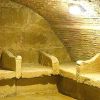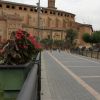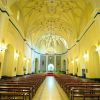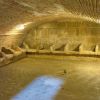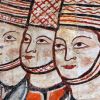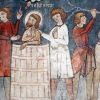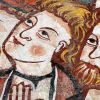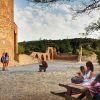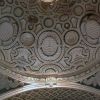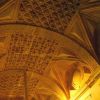Monumentos
Church and complex of San Francisco. Barbastro

At the beginning of the 13th century the middle classes had gained an important social and political position in Barbastro, commerce had brought new riches and the city in general had grown. The Cistercian and Benedictine monasteries were in crisis but in contrast, the arrival of the Franciscan monks brought new solutions for a changing society.
With a humble spirit of poverty they chose to live in the cities rather than distance themselves from the population in remote spots. Instead of waiting for people to come to them, they went out to meet the people. And rather than choosing to speak only in church, they talked to villagers, soldiers and children in the village squares.In the 13th century they set up an order in Barbastro, occupying a functional church, which followed one of the most successful religious architectural styles of the era; a single nave with chapels tucked beneath buttresses. The lack of columns or pillars within the nave allowed the congregation to see and hear the preacher without difficulty.
The building was large but constructed with modest materials such as packed earth, brick and gypsum plaster. Very little remains of the original convent rooms, such as the cloister, cells, dormitories and refectory. However, in the San Antonio square it is possible to glimpse the old floor of the cloister and the see the layout of its walls; in fact these have now been incorporated into private houses. A row of small widows that would have been the monks’ cells can still be seen upon careful inspection.
Between the 16th and 17th centuries and in two consecutive phases, the interior space of the church was transformed. The large nave was covered with stellar vaulting made out of brick. The ribs were created using plaster and the ceilings were polished. The nave was decorated with a network of brownish lines painted in such a way as to imitate the joints between ashlars, as was common in those days.
The old chapel of Claramunt, which sits at the east end, now holds the role of vestry. At the beginning of the 17th century it was decorated by Rafael Pertús, a Renaissance painter from Zaragoza. The mural paintings were finished off with a beautiful skirting board made of tiles, which were probably made in the potteries of Muel near Zaragoza.
A staircase leads down to a vaulted crypt, which has a bench that runs the length of its perimeter. This is divided into fifteen chair-like sections carved from stone. This bench was used for holding the dead, with the walls of the crypt used to support their bodies.
Sometime after the construction of the crypt, it is likely that someone questioned the good of a burial system that was so unhygienic. Because of this some of the arms that separated the sections were reduced so that coffins could be placed on the bench.
A small chapel near the east end of the building boasts beautiful star shaped rib vaults of magnificent design, dedicated to Ceferino Giménez Malla, also known as “the strong one.” Of Romani origin, he was a respected mule trader and, although illiterate, taught children to pray, encouraged them to respect birds, plants and insects and gave them bread and chocolate to eat during times of great hardship. During the Spanish civil war he was imprisoned and was later shot by a firing squad with his rosary beads in his hands. Pope John Paul II beatified him in 1987 and the sculpture of the saint that can be seen in the chapel is a work of the artist Juan de Ávalos.
Romanesque church of Santa Maria la Blanca. Berbegal
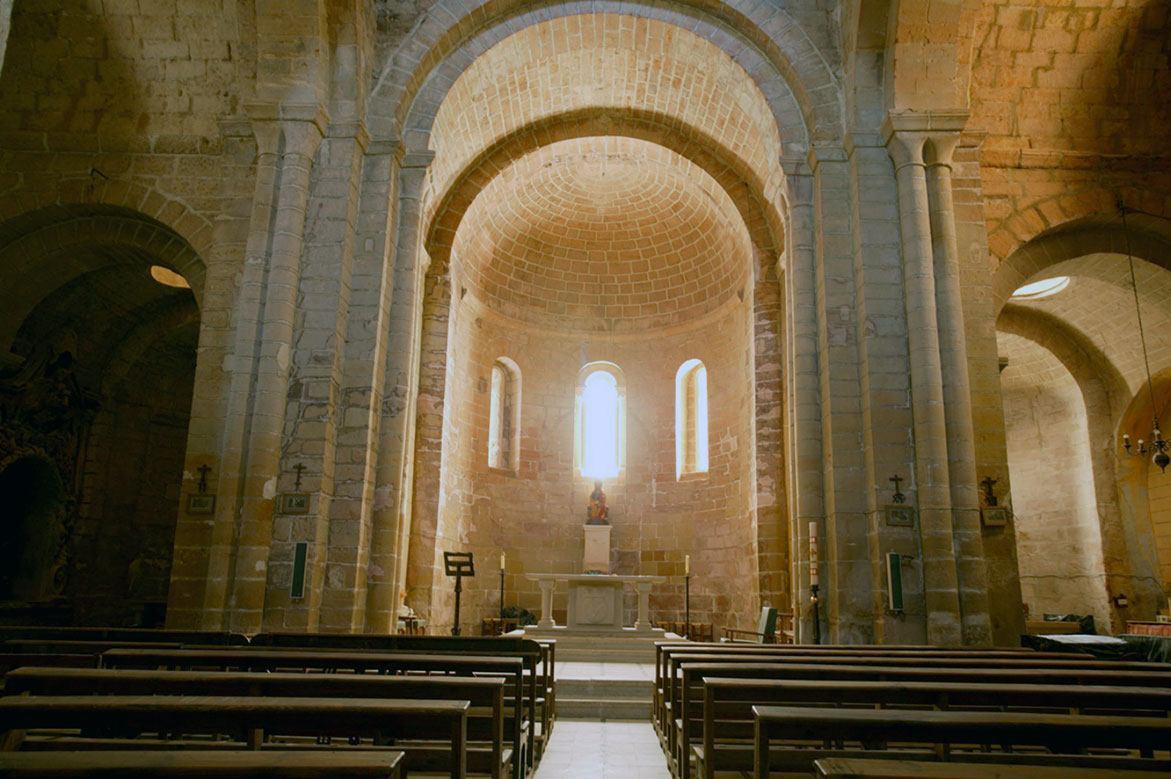
This Romanesque church was started at the beginning of the 12th century and was originally planned as a huge church with three apses and three naves topped with barrel vaults.
However work was stopped and did not restart until the end of the 12th century. Consequently the naves were hurriedly finished with the addition of only one more section that was covered with a pointed barrel vault.
As a result of the abandonment of the original project, the main body of the temple is disproportionate with respect to the central apse, which measures 5.5 metres in width. Several windows light the central apse and symbolise the holy trinity; three windows that allow in the only light, equivalent to three persons that make up the only God.
In the Romanesque temples, the main door symbolised the frontier between earth and heaven. “I am the door. By me if any man enter in, he shall be saved.” John: Chapter 10. Its symbolism was so important to the Romanesque temple that it was always the most notable element of the church’s exterior.Six archivolts rest alternately on pillars and columns. The tympanum and the lintel are embedded above the door, which is now blocked.
Christ Pantocrator was chosen to illustrate his coming in the glory of his divinity at the end of all time. In his left hand he holds the book of life and his right hand is raised in blessing. The symbols of the four evangelists are found in the corners, announcing the arrival of Christ to the world; St John is represented by and eagle; St Mark by a lion; St Matthew appears as an angel and St Luke is shown as a bull.The Chi-Rho was one of the earliest types of christograms and is one of the most characteristic elements of Aragonese Romanesque sculpture. It is made up of the first two letters of the Greek spelling of Christ; X (chi) and P (rho). The Latin S alludes to the Holy Spirit and the P to the father; the father, son and Holy Spirit are the three people that make up the one and only true God. A (alpha) and W (omega) are the first and last letters of the Greek alphabet and signify the eternity of God, the beginning and end of all things. The christogram is like a wheel and its three parts, the centre, the exterior circle and the radii are unique but are all part of the same unit, in the same way that the three people of the Trinity make up the same God. This was a popular metaphor in Romanesque sermons.
In the first decades of the 13th century the archpriesthood of Santa Maria was made up of 19 parishes. It was therefore deemed the right moment to enhance the church with the addition of a porch tower in keeping with this extended power.
Its three external walls have wide pointed arches, far removed from the solidity of Romanesque models. By decorating the tower with subtle mouldings, the uniformity of the wall is broken given the appearance of having been sculpted. The capitals are decorated with fantastic animals and dragons. It is possible to see the marks of the stone masons who worked here carved in the stone.
At around the same time that the tower was built, a façade for adorning the main altar was purchased. This was less expensive than decorating the church with murals as it only required the moving of one piece of work rather than recruiting a number of artists.
The painted work on its façade imitated the sumptuous pieces of gold, precious stones and enamelled items that the principal religious centres of western Romanesque Europe possessed. In fact, painted altar panels of this kind were an exception to those found in the rest of Europe and the majority originated from rural locations in Aragon and Catalunya, far from commercial and pilgrim routes.
The legal independence of Berbegal from the bishopric of Lérida at the time the diocese museum was being set up by a group of bishops, ensured that this magnificent piece was kept apart; a unique and exceptional legacy for its true heirs.
Mural paintings of San Fructuoso. Bierge

Although this building is now only used as a country chapel, in the past it held the role of parish church. It was constructed in the 12th century following the popular design of the era, which was characterised by simplicity and economy: a rectangular layout, square east end and a wooden roof with two slopes supported on large pointed arches.
During the Romanesque era, and following a tradition that was much older, the churches were usually painted with pictures. This had the aim of providing information about the bible and educating parishioners who could not read and write
This tradition of painting the inside of the churches with murals continued though the 13th century. However, the style began to change soon after and gave way to paintings that we now know as early Gothic (so called as they were the first of this style), French Gothic (as they originated in France) and lineal Gothic (as strong lines and old colours dominated.)
These new styles first arrived in Somontano on items of furniture, and in particular on miniatures, both of which were easy to transport. The exchange of illustrated books was fairly common betweens canons from the larger cathedrals and monks from important monasteries as they almost always had a workshop with artists and amanuenses (people who copied manuscripts) dedicated to reproducing and embellishing the holy texts. With the arrival in Huesca of the first of these small, illustrated books from France, a number of workshops sprang up in the area surrounding the cathedral. These artists often undertook more than one type of activity and many painted miniatures as well as murals. However, the origin of the murals paintings in Somontano, and many more throughout the Hoya de Huesca region, can be traced to the villages of Liesa and Ibieca.
These particular paintings present many stylistic features that are unmistakably Gothic. The colours are vibrant and bright, colours that are particularly associated with stain glass windows; those of white, red and blue. Another similarity to painted windows is the predominance of the lines over colour. This gives rise to slender figures with elegant bearing outlined by lines that afford them a sinuous flow.
A further characteristic that highlights the move away from Romanesque art is the fact that the figures are shown in scenes and are set in a definite location and time period. They are no longer hieratical, inexpressive, isolated and timeless as depicted in Romanesque art. The figures interact and exchange gestures and through the background scene or the architecture featured, they can be pinned down to a specific time and location.
These scenes were not hung by chance, they appear in registers and follow a specific order in frames, and so the origin of the first Gothic painting in miniature can be determined.
Nowadays only part of the collection of paintings that once decorated the church can be seen in Bierge as in 1949 many were removed, sold and distributed among various museums and private collections across the world. (the National Art Museum of Cataluña, the Museum of Fine Art in Toronto, the Ontario Art Gallery, the Metropolitan Museum of New York, the Joslyn Art Museum in Omaha, Nebraska and the Houston Museum in Texas).
As this removal took place, two teachers intervened in order to identify the chronology and style of the paintings. These teachers worked over two consecutive periods and are known locally as the first and second teachers of Bierge.
Dulcis Shrine. Buera

The shrine of Nuestra Señora de Dulcis is located in the vicinity of Buera. A track leaves the village and winds between fields of almond trees, cereal, vines and scrub before arriving at the shrine, a few kilometres from the centre. The building is located on a plain with an abundance of gorse, rosemary and thyme resulting in a high number of honeycombs in the area.
According to popular tradition, Our Lady appeared above one of these honeycombs in the spot where her image is now revered. This legendary event explains the devotion shown by the people who came from afar to worship in this chapel.
The apparition is said to have taken place around the 12th century and a chapel dedicated to the Virgin Mary must have already stood in this place at that time. However it was replaced in the 17th century by the current building.
The church has a single nave covered in a vault with attractive lunettes and the positioning of the two side chapels creates the shape a cross. The square shaped chancel is covered with a small dome supported by pendentives and crowned with an oculus. The vestry is joined to the north wall and the choir takes pride of place in the west end of the building. The most impressive element of this building is the magnificent interior décor made up of intricate plasterwork.
Two different ornamental repertoires are brought together in Dulcis. The first has strong Mudejar roots and can be seen on the vaulted ceiling of the nave, the south chapel and certain decorative elements in the chancel. The other is more Baroque in style, of classic western affiliation, and is found in the north chapel and other parts of the chancel.
The material used to create the motifs that adorn the inside of the chapel is plaster. It was widely used as it was ideal for the decoration of vaulted ceilings; easy to work with due to its ductility and cheap due to it being widely available in the region.
With this in mind, the decoration techniques used to decorate the ceiling of the Dulcis chapel included a combination of basic sculpture and modelling. A design was first sketched on the panels of fresh plaster followed by gentle sculpting to create the raised edges of the circular shapes. These interweave to form geometric designs and the gaps were then filled with moulded motifs.
There is nothing on the austere exterior of the church to indicate the rich splendour of the decoration to be found on the inside. This is a characteristic feature of Aragonese baroque.
Another peculiarity of this style in Aragon is the endurance of certain decorative traditions such as the Mudejar style. Despite the expulsion of the artisans responsible for its introduction, the Moors, it was still widely used in Aragon until eventually becoming a recognised decorative style in the 17th century.
This abundance of decoration masked the poor quality of the materials used in the construction of the church. These were cheap materials, such as plaster, which was used extensively to decorate the ceiling of the nave (the aforementioned Mudejar geometric motifs) and the whole of the east end.
The interior of the chapel reveals two distinct areas that stand out immediately; the simple nave, a place for the faithful, and the chancel, location of the altar. The decoration of the latter is plentiful with the use of vibrant colours highlighted by light entering from the oculus at the top of the dome. It is the most important focal point of the church and attracts all who enter towards the altar.
The decor converts the vaulted ceiling of the nave into a star filled sky, filled with soft golden light that filters in through the oculus of the church’s west end.
Telf. 620 057 721



